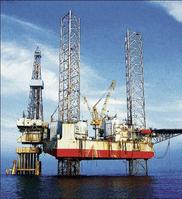Linda Hutchinson-Jafar, Business Writer

Audit leak says country's resource plunging faster than expected, but Government still boosts production - Contributed
Port-of-Spain, Trinidad :
The Trinidad and Tobago Government is expected to release details of its latest natural gas audit by mid-month following newspaper reports that the Houston-based audit consultant, Ryder Scott, found an 11 per cent decline in the country's natural gas reserves.
Last week, the Trinidad Guardian quoted sources who said the audit found proven reserves declined from 18.7 trillion cubic feet (tcf) to 16.74 tcf; probable reserves from 9.02 tcf to 7.88 tcf and possible reserves declined from 7.06 tcf to 6.26 tcf. This puts total 2006 reserves at 30.88 tcf, a significant decline from the 2005 reserves of 34.86 tcf.
The country currently has a daily gas production rate of 3.9 billion cubic feet (bcf) with 59 per cent being allocated to LNG production and 41 per cent to the domestic market, which is dominated by ammonia and methanol production.
By 2016, natural gas production is estimated to increase to 5.9 billion bcf with the allocation to LNG amounting to 53 per cent and 47 per cent to the domestic market. Based on current gas reserves position, the Ministry of Energy said it is confident that it can sustain all currently operating and approved new projects and meet domestic demand.
Aggressive exploratory project
Energy Minister, Dr. Lenny Saith, does not appear worried by the natural gas audit report. He seems focused on increasing natural gas production to meet increasing demand over the next eight years.
Government is encouraging energy companies to pursue an aggressive exploratory programme in deep water, as well as land and near shore areas to ensure that new supplies of gas are found to meet the huge gas demand of a new model of downstream industries which will include petrochemicals, plastics and metals.
At a recent energy conference in Port-of-Spain, Dr. Saith said the country's natural gas production will be boosted by the drilling of 11 new wells this year, including two on-shore at a cost of US$234 million and an additional six wells next year at a cost of US$164 million.
These activities are intended to ensure that supplies for new industrial activities, and for potential new export projects are met. Last December, the state-owned National Gas Company concluded negotiations with three gas producers - BHP Billiton, EOG Resources, and BG Trinidad and Tobago for the supply of 560 million standard cubic feet of gas per day beginning in 2009, which will be used to meet existing project commitments.
The Energy Ministry recently offered eleven onshore, near shore and shallow marine blocks and eight blocks in the deep Atlantic by the Competitive Bid Round process.
Government is expected to begin signing production sharing agreements with the approved energy companies this year. BP Trinidad and Tobago is not perturbed by findings of the audit.
Company undeterred
BPTT's vice-president of the operations performance unit, Robert Fryar, said the Ryder Scott's statistics usually include two additional classifications called 'identified exploratory resources' and 'unidentified exploratory resources'.
"These amounted all told to 57.4 tcf in 2005. Such categories of gas, of course, require drilling to promote them to the reserves category, so they are to be treated sparingly, but the term 'identified exploratory resources' suggests that there is a high probability, at least according to Ryder Scott, of such gas becoming 'reserves' if the exploration undertaken to confirm them is successful," he explained.
Fryar said the company was undeterred by the failure of its US$83 million Ibis Deep well in 2006 - drilled to a depth of 19,068 feet - and is prepared to venture into the deep horizons again to search for new reserves. He added that the company has a good idea where new energy reserves could be found in the Columbus Basin and plans to drill 10 wells over the next 10 years.
Confident of finding gas
"We are confident of finding gas in the more conventional plays, but the play will be more complex, and the prospects will be deeper and smaller in size. Basins mature. What that typically means is that pool sizes will get smaller over time. At the same time, we need to put things into perspective.Compared to other parts of the world, we are still dealing with very large quantities of gas still in the ground," Fryar said.
"That's why we are still excited about the opportunities that exist and why we have an exploration programme that calls for one well a year for 10 years. And, it's not just BPTT."
BPTT's goal, he said, is to maintain production of about 500,000 barrels of oil equivalent a day. As the largest producer in the country - about 50 per cent of total oil and gas production - Fryar said BPTT has an obligation to provide the raw material necessary for the primary gas-based products. He also sees the gas reservoirs straddling the Trinidad - Venezuela maritime border as adding to the country's gas reserves.
Treading lightly
This field is estimated to contain approximately 10 tcf of gas. Based on this, it was agreed by the technical teams from Trinidad and Tobago and Venezuela that approximately 73 per cent (7.3 tcf) of the reservoir lies on the Venezuelan side of the border with the remaining 27 per cent (2.7 tcf) on the Trinidad and Tobago side of the border.
The gas, however, cannot be produced without the agreement of both sides on monetisation. So far, a framework unitisation agreement has been signed by the two governments - the first of its kind in the western hemisphere, and discussions are now proceeding on the actual exploitation of reserve in the Manatee and Loran discoveries in Trinidad and Venezuela.
linda.hutchinson-jafar@gleanerjm.com

